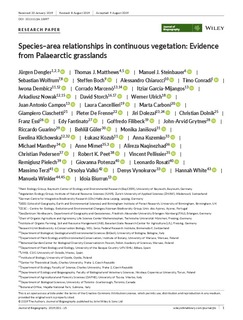Species–area relationships in continuous vegetation: Evidence from Palaearctic grasslands
| dc.contributor.author | Dengler, Jürgen | |
| dc.contributor.author | Matthews, Thomas J. | |
| dc.contributor.author | Steinbauer, Manuel J. | |
| dc.contributor.author | Wolfrum, Sebastian | |
| dc.contributor.author | Boch, Steffen | |
| dc.contributor.author | Chiarucci, Alessandro | |
| dc.contributor.author | Conradi, Timo | |
| dc.contributor.author | Dembicz, Iwona | |
| dc.contributor.author | Marcenó, Corrado | |
| dc.contributor.author | García-Mijangos, Itziar | |
| dc.contributor.author | Nowak, Arkadiusz | |
| dc.contributor.author | Storch, David | |
| dc.contributor.author | Ulrich, Werner | |
| dc.contributor.author | Campos, Juan Antonio | |
| dc.contributor.author | Cancellieri, Laura | |
| dc.contributor.author | Carboni, Marta | |
| dc.contributor.author | Ciaschetti, Giampiero | |
| dc.contributor.author | De Frenne, Pieter | |
| dc.contributor.author | Doležal, Jiří | |
| dc.contributor.author | Dolnik, Christian | |
| dc.contributor.author | Essl, Franz | |
| dc.contributor.author | Fantinato, Edy | |
| dc.contributor.author | Filibeck, Goffredo | |
| dc.contributor.author | Grytnes, John-Arvid | |
| dc.contributor.author | Guarino, Riccardo | |
| dc.contributor.author | Güler, Behlül | |
| dc.contributor.author | Janišová, Monika | |
| dc.contributor.author | Klichowska, Ewelina | |
| dc.contributor.author | Kozub, Łukasz | |
| dc.contributor.author | Kuzemko, Anna | |
| dc.contributor.author | Manthey, Michael | |
| dc.contributor.author | Mimet, Anne | |
| dc.contributor.author | Naqinezhad, Alireza | |
| dc.contributor.author | Pedersen, Christian | |
| dc.contributor.author | Peet, Robert K. | |
| dc.contributor.author | Pellissier, Vincent | |
| dc.contributor.author | Pielech, Remigiusz | |
| dc.contributor.author | Potenza, Giovanna | |
| dc.contributor.author | Rosati, Leonardo | |
| dc.contributor.author | Terzi, Massimo | |
| dc.contributor.author | Valkó, Orsolya | |
| dc.contributor.author | Vynokurov, Denys | |
| dc.contributor.author | White, Hannah | |
| dc.contributor.author | Winkler, Manuela | |
| dc.contributor.author | Biurrun, Idoia | |
| dc.date.accessioned | 2020-01-13T11:29:52Z | |
| dc.date.available | 2020-01-13T11:29:52Z | |
| dc.date.created | 2019-11-15T11:25:58Z | |
| dc.date.issued | 2019-09-19 | |
| dc.identifier.citation | Journal of Biogeography. 2019, 1-15. | nb_NO |
| dc.identifier.issn | 0305-0270 | |
| dc.identifier.uri | http://hdl.handle.net/11250/2635944 | |
| dc.description.abstract | Aim Species–area relationships (SARs) are fundamental scaling laws in ecology although their shape is still disputed. At larger areas, power laws best represent SARs. Yet, it remains unclear whether SARs follow other shapes at finer spatial grains in continuous vegetation. We asked which function describes SARs best at small grains and explored how sampling methodology or the environment influence SAR shape. Location Palaearctic grasslands and other non‐forested habitats. Taxa Vascular plants, bryophytes and lichens. Methods We used the GrassPlot database, containing standardized vegetation‐plot data from vascular plants, bryophytes and lichens spanning a wide range of grassland types throughout the Palaearctic and including 2,057 nested‐plot series with at least seven grain sizes ranging from 1 cm2 to 1,024 m2. Using nonlinear regression, we assessed the appropriateness of different SAR functions (power, power quadratic, power breakpoint, logarithmic, Michaelis–Menten). Based on AICc, we tested whether the ranking of functions differed among taxonomic groups, methodological settings, biomes or vegetation types. Results The power function was the most suitable function across the studied taxonomic groups. The superiority of this function increased from lichens to bryophytes to vascular plants to all three taxonomic groups together. The sampling method was highly influential as rooted presence sampling decreased the performance of the power function. By contrast, biome and vegetation type had practically no influence on the superiority of the power law. Main conclusions We conclude that SARs of sessile organisms at smaller spatial grains are best approximated by a power function. This coincides with several other comprehensive studies of SARs at different grain sizes and for different taxa, thus supporting the general appropriateness of the power function for modelling species diversity over a wide range of grain sizes. The poor performance of the Michaelis–Menten function demonstrates that richness within plant communities generally does not approach any saturation, thus calling into question the concept of minimal area. | nb_NO |
| dc.language.iso | eng | nb_NO |
| dc.rights | Navngivelse 4.0 Internasjonal | * |
| dc.rights.uri | http://creativecommons.org/licenses/by/4.0/deed.no | * |
| dc.subject | logarithmic function | nb_NO |
| dc.subject | Michaelis–Menten function | nb_NO |
| dc.subject | minimal area | nb_NO |
| dc.subject | nested‐plot sampling | nb_NO |
| dc.subject | nonlinear regression | nb_NO |
| dc.subject | Palaearctic grassland | nb_NO |
| dc.subject | plant biodiversity | nb_NO |
| dc.subject | power law | nb_NO |
| dc.subject | scaling law | nb_NO |
| dc.subject | species–area relationship (SAR) | nb_NO |
| dc.title | Species–area relationships in continuous vegetation: Evidence from Palaearctic grasslands | nb_NO |
| dc.type | Journal article | nb_NO |
| dc.type | Peer reviewed | nb_NO |
| dc.description.version | publishedVersion | nb_NO |
| dc.rights.holder | ©2019TheAuthors. | nb_NO |
| dc.subject.nsi | VDP::Landbruks- og Fiskerifag: 900 | nb_NO |
| dc.source.pagenumber | 1-15 | nb_NO |
| dc.source.journal | Journal of Biogeography | nb_NO |
| dc.identifier.doi | 10.1111/jbi.13697 | |
| dc.identifier.cristin | 1747978 | |
| cristin.unitcode | 7677,5,0,0 | |
| cristin.unitname | Divisjon for kart og statistikk | |
| cristin.ispublished | true | |
| cristin.fulltext | original | |
| cristin.qualitycode | 2 |
Tilhørende fil(er)
Denne innførselen finnes i følgende samling(er)
-
Divisjon for kart og statistikk [564]
Publikasjoner knyttet til ansatte ved Divisjon for kart og statistikk -
Publikasjoner fra CRIStin - NIBIO [4576]
-
Vitenskapelige artikler [1416]

